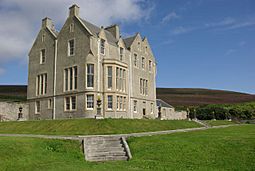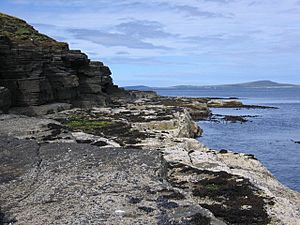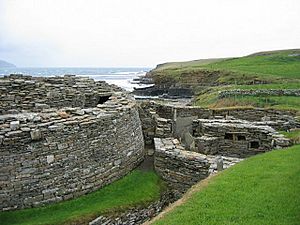Rousay facts for kids
| Norse name | Hrólfsey |
|---|---|
| Meaning of name | Old Norse for "Hrolf's island" |
 Trumland House on Rousay, designed by David Bryce who also designed Balfour Castle on Shapinsay. |
|
| OS grid reference | HY407309 |
| Coordinates | 59°10′N 3°02′W / 59.17°N 3.03°W |
| Physical geography | |
| Island group | Orkney |
| Area | 4,860 hectares (18.8 sq mi) |
| Area rank | 23 |
| Highest elevation | Blotchnie Fiold 249 metres (817 ft) |
| Administration | |
| Sovereign state | United Kingdom |
| Country | Scotland |
| Council area | Orkney Islands |
| Demographics | |
| Population | 216 |
| Population density | 4.4 people/km2 |
| Largest settlement | Brinian |
Rousay (Scots: Rousee; Old Norse: Hrólfsey) is a small, hilly island in Scotland. Its name comes from Old Norse and means "Rolf's Island." It is about 3 kilometers (2 miles) north of Mainland, which is the biggest island in the Orkney Islands.
Rousay is sometimes called the "Egypt of the North." This is because it has many important archaeological sites. These sites show a long history of people living on the island.
You can reach Rousay by a special ferry called MV Eynhallow. This ferry also connects Rousay to its nearby islands, Egilsay and Wyre. The ferry service is run by Orkney Ferries. It can carry up to 95 passengers and 10 cars.
Contents
People and Life on Rousay
In 2001, about 212 people lived on Rousay. Today, the population is over 200. Most people on the island work in farming, fishing, or fish-farming. Some also have small craft businesses or jobs related to tourism, especially in summer.
Nature and Landscape

Rousay is separated from Mainland Orkney by a narrow stretch of water called Eynhallow Sound.
A single road goes around the whole island. It is about 23 kilometers (14 miles) long. Most of the land used for farming is close to this road and the coast. Rousay is the fifth largest of the Orkney Islands. It covers an area of about 4,860 hectares (18.8 square miles).
The island has several freshwater lochs (lakes). The biggest one is called Muckle Water.
Rousay is a special place for nature. It is a 'Site of Special Scientific Interest'. This means it has important cliff shapes and many types of wildflowers. The island also has a RSPB bird reserve. Here, you can see many different kinds of birds.
Rousay is one of the hilliest Orkney islands. From its highest point, Blotchnifiold (249 meters or 817 feet), you can see amazing views of the nearby islands.
The island is home to various wildlife. You might spot seals and otters around its coasts.
Rousay's Past: A Journey Through Time
Rousay has a very long history. People first lived here during the Neolithic period, which was a very long time ago. They built a settlement at a place called Rinyo.
Over the years, many different groups of people lived on Rousay. You can find remains from:
- Bronze Age: These include "burnt mounds," which are piles of stones heated in fires.
- Iron Age: This period left behind crannogs (ancient lake dwellings) and brochs. Brochs are tall, round stone towers. Rousay has more brochs than almost anywhere else in Scotland. Three of them are very close to the coastline.
- Vikings: There are also Viking boat burials, where people were buried with their boats.
- Middle Ages: You can see parts of a medieval church.
- Later Times: There is also a large, grand house called Trumland House.
More than 100 archaeological sites have been found on Rousay. Only a few of them have been fully explored. Some of the most impressive sites are the Midhowe Broch and the Midhowe Chambered Cairn. These are ancient burial places. Other important tombs include Blackhammer Chambered Cairn, Taversoe Tuick, and Yarso.
The names of places on Rousay show its Norse history. For example, 'Hrólfs-øy' or 'Hrolfsey' means 'Hrolf's island'. Over time, this name changed to 'Rollesay', then 'Rolsay', 'Rowsay', and finally 'Rousay' in 1549.
For a long time, most people on Rousay made a living from farming and fishing. In the 1800s, there were also blacksmiths, shoemakers, and shopkeepers. Women often made clothes and braided straw.
However, in the 1820s and 1830s, many farmers, called crofters, were forced to leave their homes. This happened because the island's landlords demanded very high rents. This event is known as the "clearances."
Later, a man named General Sir Frederick Traill-Burroughs inherited much of the island. He was known as "the little general" because he was short. He built a large house at Trumland. From 1870 to 1883, he made many improvements to the island. These included:
- Building Trumland pier.
- Setting up island schools.
- Creating a public market.
- Starting the first steamship service.
- Opening a post office.
- Bringing the first doctor to live on the island.
In the mid-1800s, over 900 people lived on Rousay. But after the clearances, the population dropped to 627 by 1900. By the 1970s, it was only 181, its lowest ever. Since then, new families have moved to Rousay, and the population is now over 200.
There is a local legend about the Yetnasteen stone. People say it was once a giant who comes alive every New Year at midnight. The giant then visits the Loch of Scockness to drink.
Learning on Rousay
Rousay has a primary school for children aged 3 to 12. About 24 boys and girls attend this school. After finishing primary school, students go to high school. They usually attend Kirkwall Grammar School or Stromness Academy on Mainland Orkney.
Famous People from Rousay
Several interesting people have connections to Rousay:
- Pauline Stainer: A poet who lived on the island for several years. In 1999, she published a book of poems about Rousay called Parable Island.
- Robert C. Marwick: Born on Rousay, he was a school teacher and headmaster. He wrote books about the island, including From My Rousay Schoolbag (1995) and Rousay Roots (1995).
- John Vetterlein: An astronomer, musician, and writer. He moved to Rousay full-time in 1995 and started a small publishing company there.
- Graham Fellows: An actor who owns an old church on the island. He plans to turn it into a place for artists.
- Margaret Gardiner: A late artist who spent much of her life on Rousay. In 1979, she founded the Pier Art Gallery in Stromness.
Rousay Sound: A Special Underwater Place
Rousay Sound is the water that separates Rousay from the island of Egilsay. This sound has very strong tides. These tides help create special underwater beds of a plant-like algae called maerl.
These maerl beds are important. They provide a safe home for many sea creatures. You can find peacock worms, different types of sponges, small fish, shrimps, gobies, and crabs living there.
Since 2014, Rousay Sound and the nearby Wyre Sound have been named a Nature Conservation Marine Protected Area (NCMPA). This means the area is protected to help keep its marine life safe. Certain fishing activities are not allowed there, such as dredging or trawling.
|
See also
 In Spanish: Rousay para niños
In Spanish: Rousay para niños


